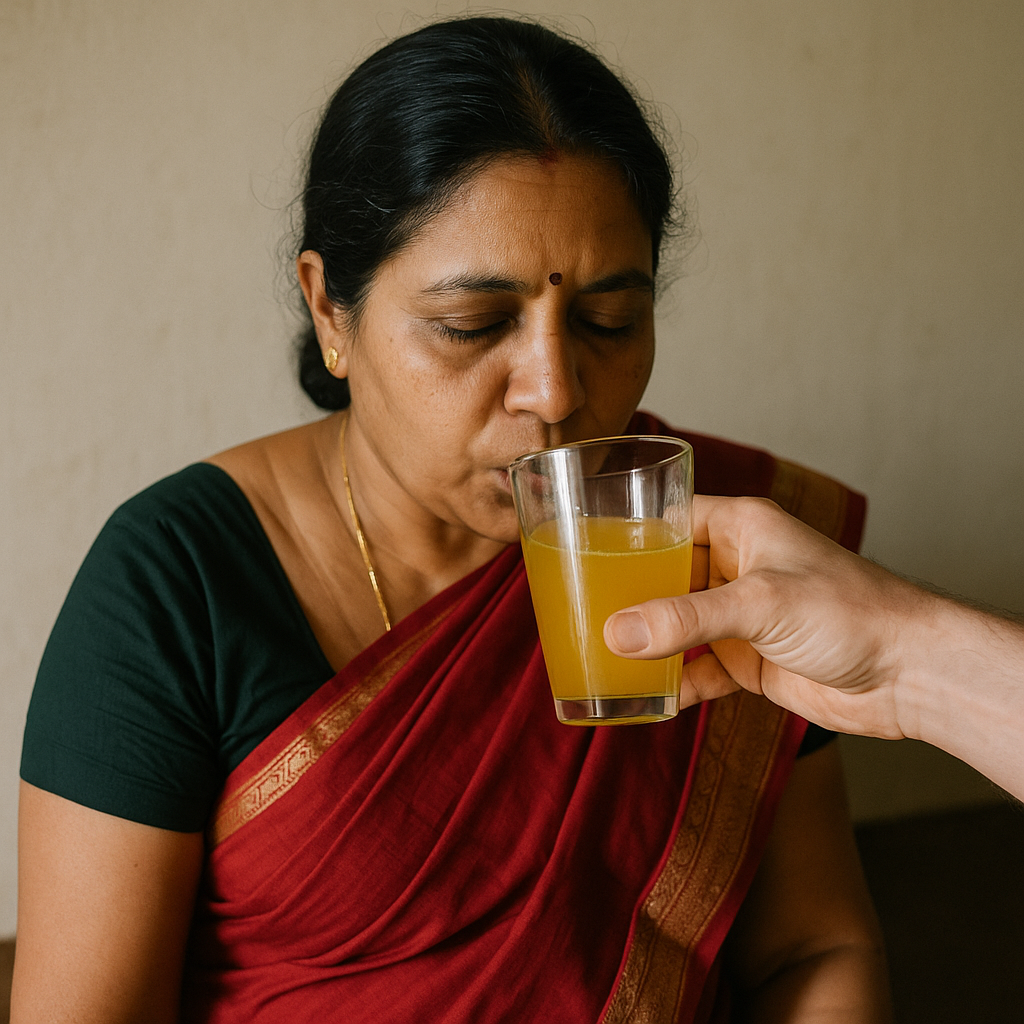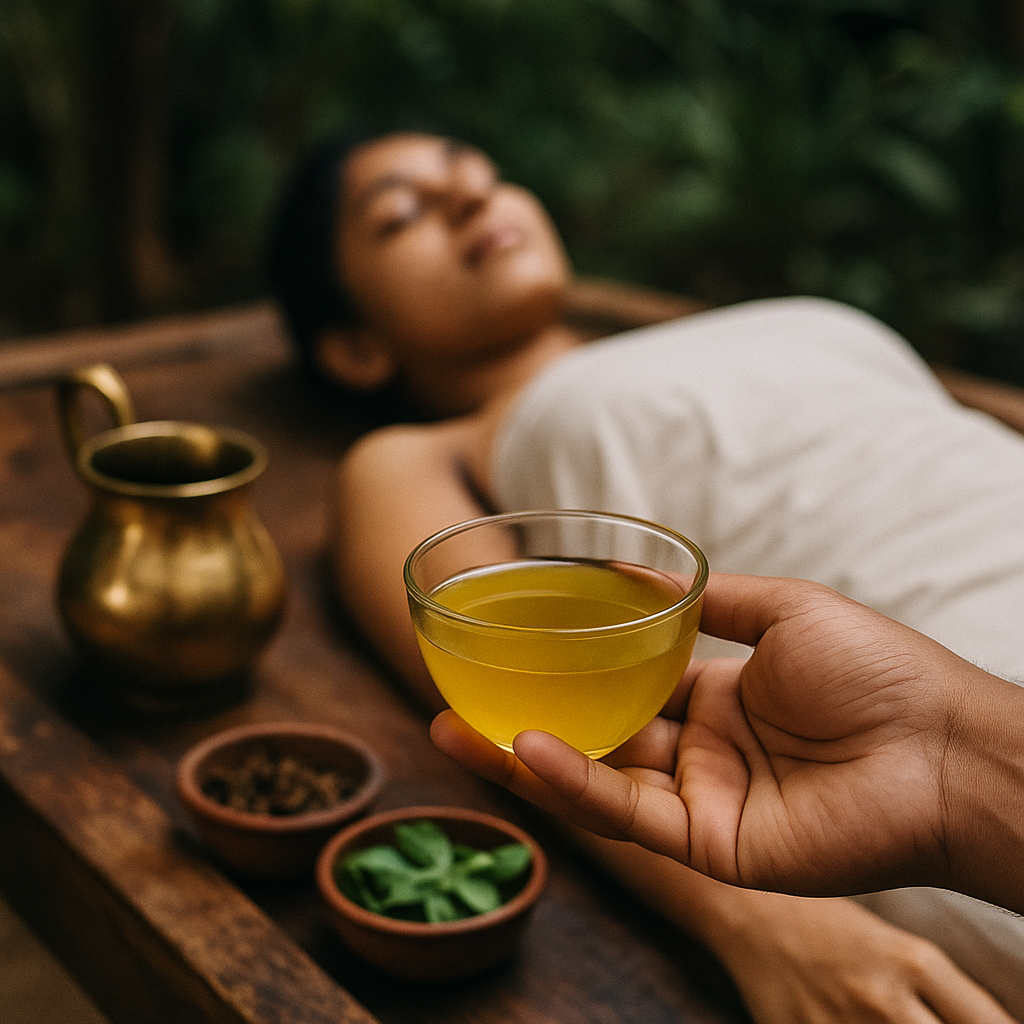आयुर्वेदिक डॉक्टर से प्रश्न पूछें और निःशुल्क या भुगतान मोड में अपनी चिंता की समस्या पर ऑनलाइन परामर्श प्राप्त करें। 2,000 से अधिक अनुभवी डॉक्टर हमारी साइट पर काम करते हैं और आपके प्रश्नों का इंतजार करते हैं और उपयोगकर्ताओं को उनकी स्वास्थ्य समस्याओं को हल करने में प्रतिदिन मदद करते हैं।
अभी हमारे स्टोर में खरीदें
आयुर्वेद में स्नेहपान क्या है?

जब लोग पूछते हैं, आयुर्वेद में स्नेहपान क्या है, तो इसका जवाब सिर्फ एक साधारण परिभाषा से कहीं अधिक होता है। यह एक विशेष चिकित्सा है, जो प्राचीन आयुर्वेदिक ज्ञान में गहराई से जड़ें जमाए हुए है, और पंचकर्म के सबसे महत्वपूर्ण तैयारी चरणों में से एक माना जाता है। स्नेहपान प्रक्रिया में घी (स्पष्ट मक्खन) या औषधीय तेलों का सावधानीपूर्वक मापी गई खुराक में आंतरिक सेवन शामिल होता है। यह अभ्यास पहली नजर में असामान्य लग सकता है, लेकिन वास्तव में, यह हजारों वर्षों से विषहरण और उपचार का एक आधार रहा है। स्नेहपान का अर्थ स्वयं शरीर से विषाक्त पदार्थों को निकालने और मन और शरीर में संतुलन बहाल करने के लिए मार्गदर्शन करने वाले दर्शन और अभ्यास की परतों को प्रकट करता है। यदि आपने कभी स्नेहपान के लाभ, या यहां तक कि स्नेहपान के संभावित दुष्प्रभावों के बारे में सोचा है, तो यह गाइड आपको इतिहास, अर्थ, और चरण-दर-चरण प्रक्रिया से लेकर आज के आयुर्वेदिक उपचारों में इसके स्थान तक सब कुछ बताएगा।
आयुर्वेद में स्नेहपान का अर्थ और भूमिका
"स्नेहपान" का क्या अर्थ है?
शब्द स्नेहपान दो संस्कृत शब्दों से बना है: स्नेह, जिसका अर्थ है तेल या वसा (अक्सर प्रेम और अभिषेक से भी जुड़ा होता है), और पान, जिसका अर्थ है पीना या सेवन करना। तो, स्नेहपान का अर्थ है "घी या तेल का मौखिक सेवन।" आयुर्वेद में, वसा को केवल भोजन के रूप में नहीं देखा जाता है, बल्कि औषधीय गुणों के वाहक के रूप में देखा जाता है। जब जड़ी-बूटियों के साथ मिलाया जाता है, तो घी या तेल एक चिकित्सीय माध्यम में बदल जाता है जो ऊतकों में गहराई तक प्रवेश करने और गहरे बैठे विषाक्त पदार्थों को बाहर निकालने में सक्षम होता है।
यह पंचकर्म में कहाँ फिट बैठता है
आयुर्वेद पंचकर्म को पांच मुख्य विषहरण और पुनर्जीवन प्रक्रियाओं के रूप में वर्णित करता है। इन गहन सफाई चिकित्सा से पहले, शरीर को ठीक से तैयार किया जाना चाहिए। यहीं पर स्नेहपान उपचार आता है। यह पूर्वकर्म (तैयारी चरण) के प्राथमिक चरणों में से एक है। शरीर की नलिकाओं में फंसे विषाक्त पदार्थों (जिन्हें अमा कहा जाता है) को नरम और ढीला करके, स्नेहपान यह सुनिश्चित करता है कि उन्मूलन चिकित्सा—जैसे वमन (चिकित्सीय उल्टी) या विरेचन (पर्जन)—अधिक सुचारू रूप से काम करें। इस तैलीय तैयारी के बिना, वास्तविक पंचकर्म कठोर, कम प्रभावी, या कुछ मामलों में असुरक्षित भी महसूस हो सकता है।

स्नेहपान प्रक्रिया: चरण-दर-चरण प्रक्रिया
तैयारी चरण (पूर्वकर्म)
स्नेहपान प्रक्रिया शुरू करने से पहले, एक वैद्य (आयुर्वेदिक चिकित्सक) रोगी की प्रकृति (प्रकृति), पाचन शक्ति (अग्नि), और स्वास्थ्य स्थिति का मूल्यांकन करता है। आमतौर पर एक दिन पहले हल्का, आसानी से पचने वाला भोजन सलाह दी जाती है। चिकित्सक यह सुनिश्चित करता है कि पेट और आंतें वसा के सेवन के लिए तैयार हैं, अन्यथा असुविधा हो सकती है। यह एक "एक आकार सभी के लिए फिट" प्रक्रिया नहीं है, जिसे याद रखना महत्वपूर्ण है।
उपयोग किए जाने वाले औषधीय घी या तेल के प्रकार
स्नेहपान आयुर्वेदिक उपचार में उपयोग की जाने वाली सामग्री भिन्न हो सकती है। कुछ लोग सादा घी ले सकते हैं, जबकि अन्य को त्रिफला, दशमूल, या पिप्पली जैसी जड़ी-बूटियों के साथ तैयार किया गया औषधीय घी दिया जाता है। कुछ स्थितियों में तिल का तेल भी उपयोग किया जा सकता है। इसका चयन उस बीमारी पर निर्भर करता है जिसका इलाज किया जा रहा है—पाचन समस्याएं, जोड़ों की जकड़न, या यहां तक कि त्वचा रोग।
खुराक और अवधि
खुराक अत्यधिक व्यक्तिगत होती है। कुछ रोगी 30 मिलीलीटर घी से शुरू कर सकते हैं, धीरे-धीरे दैनिक रूप से बढ़ाते हुए जब तक कि उनका शरीर उचित तैलन के संकेत नहीं दिखाता (जैसे नरम मल, त्वचा पर हल्की तैलीयता, या बेहतर पाचन)। स्नेहपान अनुभव 3 से 7 दिनों तक चल सकता है, प्रतिक्रिया पर निर्भर करता है। अवधि महत्वपूर्ण है—बहुत कम और यह शरीर को पूरी तरह से तैयार नहीं करेगा, बहुत लंबा और यह भारीपन, मतली या सूजन का कारण बन सकता है।
शरीर और मन के लिए स्नेहपान के लाभ
पाचन में सुधार और विषाक्त पदार्थों का उन्मूलन
एक प्रमुख स्नेहपान लाभ बेहतर पाचन और उन्मूलन है। पाचन तंत्र को चिकना करके, यह विषाक्त पदार्थों को ऊतकों से अलग करने और गैस्ट्रोइंटेस्टाइनल सिस्टम की ओर बढ़ने की अनुमति देता है, जो निष्कासन के लिए तैयार होता है। कई रोगी कुछ दिनों के बाद हल्के शरीर और बेहतर मल त्याग की रिपोर्ट करते हैं।
तंत्रिका तंत्र को शांत करना
दिलचस्प बात यह है कि यह अभ्यास केवल आंत को लक्षित नहीं करता है। औषधीय घी का सेवन तंत्रिका तंत्र को पोषण देता है और तनाव को शांत करने में मदद करता है। कुछ लोग अपने स्नेहपान अनुभव को अजीब तरह से स्थिर करने वाला बताते हैं, जैसे कि उनका मन शांत और कम बेचैन महसूस करता है, भले ही घी का स्वाद शुरू में अप्रिय हो सकता है।
त्वचा और जोड़ों के स्वास्थ्य का समर्थन
क्योंकि वसा ऊतक की मरम्मत में एक प्रमुख भूमिका निभाते हैं, स्नेहपान उपचार को अक्सर बेहतर त्वचा की चमक और जोड़ों की गतिशीलता के साथ जोड़ा जाता है। जब शरीर भीतर से अच्छी तरह से तैलीय होता है, तो सूखापन, दरारें, और जकड़न कम हो जाती हैं। कई आयुर्वेदिक ग्रंथ इस बात पर जोर देते हैं कि घी जड़ी-बूटी की शक्ति को साथ ले जाते हुए ऊतकों की सबसे गहरी परतों में "घुसपैठ" करता है।

आयुर्वेदिक उपचार में स्नेहपान का अभ्यास
कौन स्नेहपान ले सकता है और कब
हर कोई स्नेहपान आयुर्वेदिक उपचार के लिए उपयुक्त नहीं होता, और यही कारण है कि यह इतना प्रभावी बना रहता है। एक योग्य चिकित्सक सही समय, मौसम, और रोगी की वर्तमान स्वास्थ्य स्थिति का आकलन करता है। पारंपरिक रूप से, स्नेहपान पंचकर्म की तैयारी कर रहे व्यक्तियों या उन लोगों के लिए अनुशंसित है जो गठिया, त्वचा विकार, पाचन विकार, या तंत्रिका तंत्र असंतुलन जैसी पुरानी समस्याओं से पीड़ित हैं।
समय महत्वपूर्ण है। आयुर्वेद अक्सर इस चिकित्सा को मौसम के परिवर्तन पर, विशेष रूप से मानसून और सर्दियों से पहले, जब शरीर स्वाभाविक रूप से विषाक्त पदार्थों को जमा करता है, पर निर्धारित करता है। लेकिन यहाँ एक पकड़ है: यदि आपका पाचन कमजोर है या यदि आपने हाल ही में भारी भोजन किया है, तो वैद्य शुरू करने में देरी कर सकते हैं। अन्यथा, स्नेहपान प्रक्रिया मतली या भूख की कमी के साथ उल्टा पड़ सकती है।
यह किन चिकित्सा से पहले होता है (जैसे वमन, विरेचन)
स्नेहपान उपचार की मुख्य भूमिकाओं में से एक अन्य पंचकर्म चिकित्सा के लिए शरीर को तैयार करना है। यह बेकिंग से पहले ओवन को प्री-हीट करने जैसा है—इसके बिना, मुख्य प्रक्रिया इच्छित परिणाम नहीं दे सकती है।
-
वमन (चिकित्सीय उल्टी): मुख्य रूप से कफ से संबंधित विकारों जैसे पुरानी खांसी, अस्थमा, या त्वचा रोगों के लिए उपयोग किया जाता है। स्नेहपान जमा कफ को नरम और गतिशील बनाता है ताकि वमन इसे प्रभावी ढंग से बाहर निकाल सके।
-
विरेचन (पर्जन): अतिरिक्त पित्त दोष को लक्षित करता है, जो आमतौर पर यकृत की समस्याओं, त्वचा पर चकत्ते, और पाचन सूजन से जुड़ा होता है। स्नेहपान के माध्यम से उचित तैलन यह सुनिश्चित करता है कि पित्त और विषाक्त पदार्थ बिना अधिक तनाव के बाहर निकल सकें।
-
बस्ती (औषधीय एनीमा): यहां तक कि जब एनीमा की योजना बनाई जाती है, तो डॉक्टर पहले हल्का स्नेहपान सलाह दे सकते हैं ताकि आंतें अधिक ग्रहणशील हो सकें।
तो, कई मायनों में, स्नेहपान केवल एक स्टैंड-अलोन चिकित्सा नहीं है बल्कि एक पुल भी है जो अन्य गहरी चिकित्सा को जोड़ता और बढ़ाता है।
स्नेहपान के दुष्प्रभाव और निषेध
सामान्य हल्के प्रतिक्रियाएं
हालांकि स्नेहपान के लाभ अच्छी तरह से प्रलेखित हैं, कुछ हल्की प्रतिक्रियाएं भी हो सकती हैं जो लोग देख सकते हैं। उदाहरण के लिए, प्रक्रिया के दौरान भारीपन महसूस करना, हल्की मतली, या ढीले मल fairly आम हैं। कुछ लोग घी के स्वाद के साथ डकार लेने की भी रिपोर्ट करते हैं (ईमानदारी से कहें तो यह बहुत सुखद नहीं है)। ये आमतौर पर चिंताजनक नहीं होते—वे सिर्फ यह दर्शाते हैं कि शरीर अचानक वसा सेवन के लिए समायोजित हो रहा है। हाइड्रेशन और हल्की हर्बल चाय अक्सर इस चरण को संतुलित करने के लिए अनुशंसित की जाती हैं।
स्नेहपान के दुष्प्रभाव आमतौर पर अस्थायी होते हैं और प्रक्रिया पूरी होने के बाद फीके पड़ जाते हैं। वास्तव में, कई चिकित्सक रोगियों को आश्वस्त करते हैं कि ये प्रतिक्रियाएं संकेत हैं कि चिकित्सा काम कर रही है। फिर भी, इसे करीब से मॉनिटर करना महत्वपूर्ण है, क्योंकि अत्यधिक सेवन या गलत समय संतुलन को बिगाड़ सकता है।
जब स्नेहपान की सिफारिश नहीं की जाती है
आयुर्वेदिक ग्रंथों में स्पष्ट निषेध हैं। बहुत कमजोर पाचन, तीव्र दस्त, या सक्रिय बुखार वाले लोगों को स्नेहपान आयुर्वेदिक उपचार नहीं करना चाहिए। यह अनियंत्रित मधुमेह, गंभीर मोटापा, या यकृत की भीड़ वाले लोगों के लिए भी अनुशंसित नहीं है।
गर्भवती महिलाएं, बच्चे, और बुजुर्ग व्यक्तियों का सावधानीपूर्वक मूल्यांकन किया जाना चाहिए इससे पहले कि उन्हें इस चिकित्सा की सलाह दी जाए। आयुर्वेद का सुनहरा नियम यहां लागू होता है: "जो एक को ठीक करता है वह दूसरे को नुकसान पहुंचा सकता है।" इसलिए भले ही स्नेहपान प्रक्रिया ने सदियों की कसौटी पर खरा उतरा है, फिर भी इसे व्यक्तिगतकरण की आवश्यकता होती है।
निष्कर्ष
तो, हमारे मूल प्रश्न पर वापस आते हैं—आयुर्वेद में स्नेहपान क्या है? यह सिर्फ घी पीने से कहीं अधिक है। यह एक सावधानीपूर्वक निर्देशित प्रक्रिया है, जो विज्ञान और परंपरा का हिस्सा है, जिसका उद्देश्य शरीर को गहराई से उपचार के लिए साफ, पोषण और तैयार करना है। स्नेहपान का अर्थ समझने से लेकर इसके लाभ, प्रक्रिया, और यहां तक कि संभावित दुष्प्रभावों के बारे में जानने तक, हम देख सकते हैं कि यह प्राचीन अभ्यास आज भी क्यों मूल्यवान है।
जब सही तरीके से किया जाता है, तो स्नेहपान अनुभव परिवर्तनकारी हो सकता है, लोगों को हल्के शरीर, शांत मन, और बेहतर स्वास्थ्य के साथ छोड़ सकता है। लेकिन बिना उचित मार्गदर्शन के प्रयास करने पर, यह असुविधा का कारण बन सकता है। संदेश सरल है: हमेशा स्नेहपान का सम्मान के साथ और एक कुशल आयुर्वेदिक डॉक्टर की देखरेख में करें।
अक्सर पूछे जाने वाले प्रश्न
स्नेहपान के लिए कितने दिन आवश्यक हैं?
आमतौर पर 3 से 7 दिन। कुछ रोगियों को केवल 3 दिन की आवश्यकता हो सकती है, जबकि अन्य को उनके प्रकृति और शरीर के तैलन के संकेत दिखाने की गति के आधार पर अधिक समय की आवश्यकता होती है।
स्नेहपान के दौरान हमें क्या खाना चाहिए?
हल्का, गर्म, और आसानी से पचने वाला भोजन आदर्श है। चावल का दलिया, पतले सूप, और साधारण खिचड़ी आमतौर पर अनुशंसित हैं। तले हुए, भारी, या मसालेदार भोजन से बचें जो पाचन को बाधित कर सकते हैं।
क्या कोई भी स्नेहपान ले सकता है?
नहीं। जबकि कई लोग इससे लाभ उठा सकते हैं, कुछ विशेष निषेध हैं। इस चिकित्सा को शुरू करने से पहले हमेशा एक आयुर्वेदिक चिकित्सक से परामर्श करें।
यह लेख वर्तमान योग्य विशेषज्ञों द्वारा जाँचा गया है Dr Sujal Patil और इसे साइट के उपयोगकर्ताओं के लिए सूचना का एक विश्वसनीय स्रोत माना जा सकता है।

